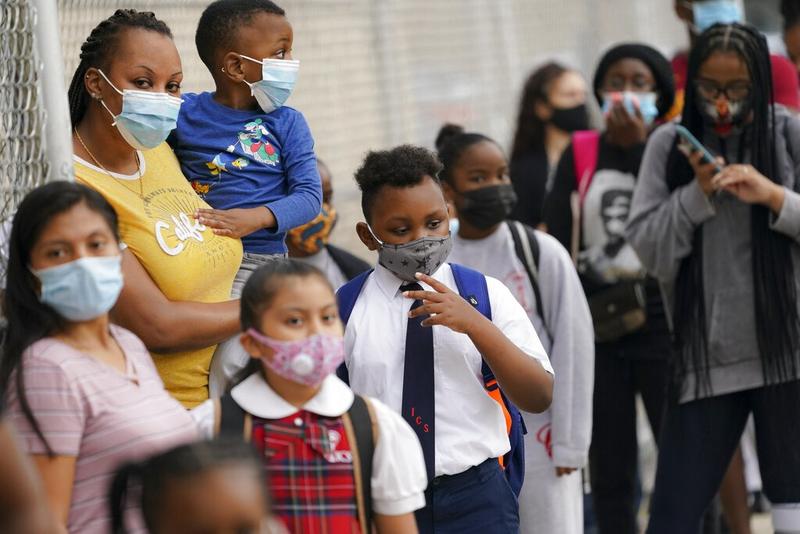 FILE - In this Sept 9, 2020, file photo, students wear protective masks as they arrive for classes at the Immaculate Conception School while observing COVID-19 prevention protocols in The Bronx borough of New York. (JOHN MINCHILLO / AP)
FILE - In this Sept 9, 2020, file photo, students wear protective masks as they arrive for classes at the Immaculate Conception School while observing COVID-19 prevention protocols in The Bronx borough of New York. (JOHN MINCHILLO / AP)
New York has twice postponed the opening of its public-school system, the largest in the United States, and as it tries for a third time on Monday with a phased return to classrooms, parents and teachers are worried.
Parents, educators and elected officials have reacted to the postponements with anger and confusion. It is unclear how many parents will send their children back to classrooms
The youngest children and 225,000 students with advanced special needs will be the first to return. Elementary schools will open on Sept 29, and middle and high schools will open on Oct 1.
There will be a mixture of both in-class instruction and remote learning. No large district in the country has yet tried to reopen schools on a hybrid basis.
ALSO READ: US COVID-19 death toll nears 200,000, tally close to 6.8m
The two opening postponements were ordered by Mayor Bill de Blasio so the system that has 1.1 million children could handle a threatened shortage of teachers in schools and ensure that buildings could open safely.
"We are doing this to make sure that all the standards we've set can be achieved," he said.
Heads of unions representing teachers and administrators have been warning for weeks that schools are not ready to reopen for a number of reasons, from poor ventilation in some of the system's 1,800 buildings to a staffing shortage that the principals' union estimated could leave the city needing as many as 10,000 educators.
Parents, educators and elected officials have reacted to the postponements with anger and confusion. It is unclear how many parents will send their children back to classrooms. Before the second postponement, The New York Times reported that nearly 40 percent of families had opted to have their children learn fully remotely when the schools reopen.
Parents of children with disabilities and children's rights advocates are particularly concerned whether there will be stringent safety protocols by trained staff to keep them safe from COVID-19 and adequate access to the city's school buses.
Buses that transport them must have wheelchair access and aides to help, which can be challenging during normal times, let alone after a pandemic. Arranging bus pickup schedules and detailing routes usually takes place in spring, but COVID-19 changed that.
Before the pandemic, New York school buses transported about 150,000 students a day. But nearly 75 percent of school-bus breakdowns and delays have involved special education buses, according to an analysis done by Education Week, an independent news organization that covers K-12 education.
Vigilance on school buses
De Blasio announced on Sept 9 that at least 100,000 school bus seats would be available for children when in-class instruction starts. Students with disabilities and those who live in shelters are legally entitled to the city's yellow bus service.
School buses will carry 25 percent fewer children to maintain social distancing, everyone must wear masks onboard and buses will be disinfected overnight, he said.
"Kids with special needs are entitled to a seat," said Maggie Moroff, special education policy coordinator for Advocates for Children of New York, an organization that works on behalf of children at risk of discrimination based on race, disability and poverty.
For emotionally disturbed children, those with autism or with severe learning difficulties, wearing a mask and social distancing may be difficult.
"We are definitely concerned that some of the (children) are going to struggle," Moroff said. "We've made recommendations to the department of education, and they are working with school staff to find a way to work with students to make sure that they do develop a level of comfort with the PPE (personal protective equipment)."
In March the Governor of New York state, Andrew Cuomo, shut all schools to stop the spread of the coronavirus. De Blasio then followed in the city.
At least 56 schools across the city have been confirmed as having COVID-19 cases. Two confirmed cases were discovered in separate classes at a school in the Bronx for students with special needs. The school closed for 24 hours to undergo an investigation by city health officials and reopened last week.
About 18,000 students at nonpublic schools are eligible for the free yellow bus service, the Office of Pupil Transportation said.
One of them is the 11-year-old son of Ivette Rivera-Giusti. She criticized de Blasio for introducing the bus service too late for her son and many other children who weeks ago started in-person classes at private schools funded by the state. She has been forced to drive her son to a school in Queens, an hour or two from their home, affecting her work schedule, she said.
READ MORE: NY lockdown cut spread by 70 percent, study finds
"(The mayor) already failed by not providing busing on the first day of school for this particular group of students who are supposed to get busing from the district," she told Chalkbeat New York, a nonprofit news organization that covers the effort to improve schools.
But the city's education department has set up a reimbursement procedure for parents who had to pay for their children to be transported to a private school.
belindarobinson@chinadailyusa.com


